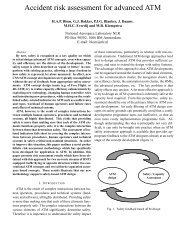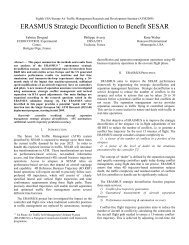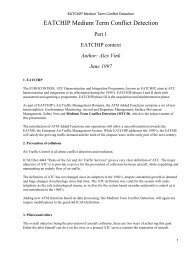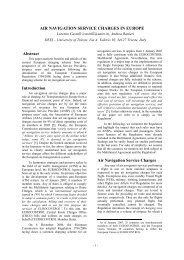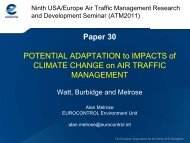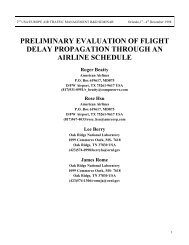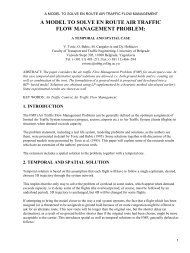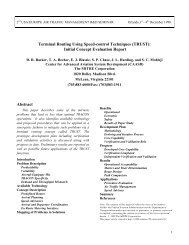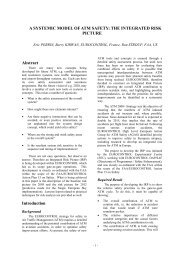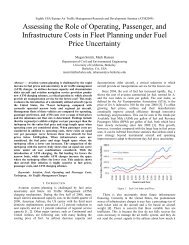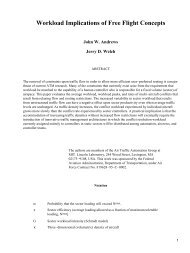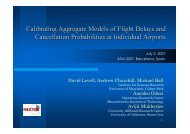Air-Rail Inter-modality From Passenger Perspective - ATM Seminar
Air-Rail Inter-modality From Passenger Perspective - ATM Seminar
Air-Rail Inter-modality From Passenger Perspective - ATM Seminar
Create successful ePaper yourself
Turn your PDF publications into a flip-book with our unique Google optimized e-Paper software.
Implementing the values above into the demandequation the percentage of passengers choosingair transport is 43% and passengers prefer railadd up to 57%. This breakdown changes whenany factor input changes.Paris – BrusselsThis was one of the busiest air routes priorto the introduction of the Thalys. Recently, highspeedtrain has replaced all the flights, sincepassengers had realized the time saving. Underthe terms of agreement, <strong>Air</strong> France replaced itsflights with chartered Thalys coaches betweenBrussels-Midi and Roissy-Charles De Gaulle andshowed willingness to go in this direction ratherthan trying to compete directly. But it was alsofeasible because of the rail link being at CDG.Without this, it might not have happened.In order to compare the air and railbreakdown we suppose that there are still flightsbetween Paris and Brussels without a stopover.The flight time is 50 min, and the train journeytakes 1h20. For ease of comparison, all the otherattributes (walk/wait time, cost to/fromairport/station, etc.) remain the same. Thedemand equation results in 34% for air transportand 66% for rail transport. In reality, it isimpossible to measure, since as alreadymentioned the high-speed train is the onlytransport option.According to these results, aviation shouldcapture 34% of the passenger traffic. We canconclude that even if there is 34% of air share, itis not enough to keep the air market alive, sinceairlines stopped operating on this route. Ofcourse reasons could have been various.Other destinationsIt is interesting to compare the value forbreakdown between the European mostconstrained routes. According the CAA airportstatistics and ICAO data, the routes supportingthe largest traffic in passenger km’s for last fewyears were the following.1 London-Dublin 11 London-Munich2 London-Paris 12 London-Geneva3 London-Amsterdam 13 Copenhagen-Oslo4 London-Frankfurt 14 Paris-Milan5 London-Zurich 15 Paris-Madrid6 London-Rome 16London-Dusseldorf7 London-Milan 17 Paris-Frankfurt8 London-Madrid 18London-Stockholm9 London-Copenhagen 19 Copenhagen-Stock10 Paris-Rome 20 Paris-AmsterdamOut of the 20 busiest routes in Europe, 9 areabove 1000 km, 3 routes are between 800-900km and 8 are less then 800 km. In theory highspeedtrain can replace 40% of the 20 busiestroutes. For less time sensitive passengers thepercentage rises to 55%.<strong>Inter</strong>-<strong>modality</strong> with rail will producesignificant capacity gains by transformingcompetition between rail and air intocomplementary between the two modes, withhigh-speed train connections between cities. Wecan no longer think of maintaining air links todestinations for where there is a competitivehigh-speed rail alternative. In this way, capacitycould be transferred to routes where no highspeedrail services exist. More efficient, morerational use of airports will not obviate the needfor increase in capacity. The fact is that newairport projects are few in number (Lisbon,Berlin, Paris).5. ConclusionPreliminary results obtained seem to open anew spectrum of questions. As mentionedbefore it would be interesting to see a differentmix of participants as well as a differentquestionnaire asking passengers to rank theirpriorities instead of assigning an importance toeach attribute. At the moment more attention isgiven to true air-rail co-operation (plane-train,train-plane) rather than surveying each modeseparately, following the door-to-door transportscheme. Up-to-date results slightly vary frompreliminary results, mainly because the averagespeed of both transport modes was overestimatedin the beginning. Study continues on the decisionmaking model, also the parameters influencingdecision making are observed in a more detailedway. Another questionnaire is foreseen, at thistime focusing on passengers passing throughinter-modal terminals (Paris CDG, FrankfurtMain, Oslo Gardemoen, Lyon Satolas, Zurich<strong>Air</strong>port, Brussels <strong>Inter</strong>national). <strong>Passenger</strong>sgiven the choice to travel both modes will be ourmain source of information. Another survey isplanned, examining passengers at travel agenciesin order to gain a better knowledge ofpassengers’ trade off between various travelfactors. Having passengers feedback and soundknowledge of their expectations will help toidentify the reduction in air transport demand.The era of transport rivalry mustbecome a thing of the past. If mobility is to besafeguarded in the long term, the modes willhave to work together. In the long term,intelligent division of labor is indispensable,each mode covering that part of the transportchain for which it is best suited.8



